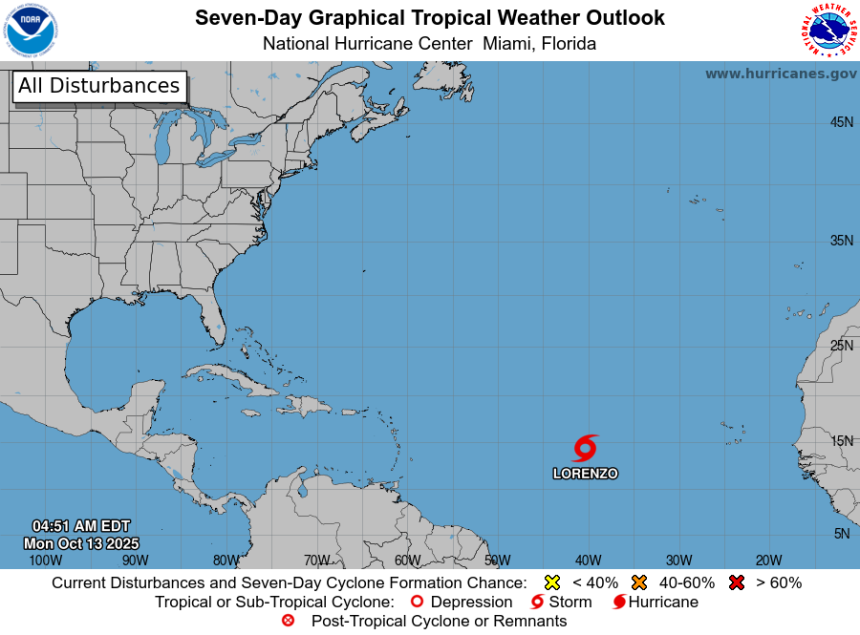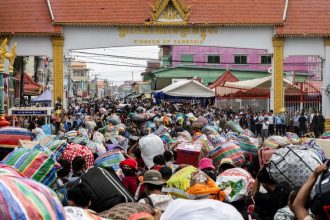Tropical Storm Lorenzo formed Monday morning, Oct. 13, in the central Atlantic, according to the National Hurricane Center.
Models vary widely on how strong Lorenzo could get in the coming days, ranging from a weak tropical storm to a Category 2 hurricane, the National Hurricane Center said. A Category 2 hurricane has maximum sustained winds ranging from 96 to 110 mph.
➤ Weather alerts via text: Sign up to get updates about current storms and weather events by location
Forecasters predict Lorenzo will turn north well away from Florida and the United States.
Lorenzo is the 12th named storm of the 2025 Atlantic hurricane season and the third storm to form since Oct. 1.
The National Hurricane Center also is tracking a tropical wave in the eastern Atlantic.
Lorenzo formed right after a powerful nor’easter, the first of the season, started bringing dangerous waves, high winds and heavy rain to the U.S. East Coast.
As the storm moves north, forecasters warned it could bring hazards to coastal communities from Virginia to Massachusetts, including power outages, travel disruptions, and marine dangers with seas topping 10 feet, according to the National Weather Service.
The next named storm of the season will be Melissa.
Here’s the latest advisory from the National Hurricane Center as of 5 a.m., Oct. 13:
Tropical Storm Lorenzo forms in central Atlantic. Will it become hurricane?
Special note on the NHC cone: The forecast track shows the most likely path of the center of the storm. It does not illustrate the full width of the storm or its impacts, and the center of the storm is likely to travel outside the cone up to 33% of the time.
-
Location: 1,095 miles west of the Cabo Verde Islands; 2,702 miles east of West Palm Beach, Florida
-
Maximum wind speed: 45 mph
-
Direction: northwest at 17 mph
At 5 a.m., the center of Tropical Storm Lorenzo was located near latitude 14.2 North, longitude 40.3 West.
Lorenzo is moving toward the northwest near 17 mph and this motion with some gradual slowdown is expected through tonight, followed by a turn northward on Tuesday.
Maximum sustained winds are near 45 mph, with higher gusts. Little change in strength is forecasted today, but some gradual intensification is possible by the middle portion of this week.
Tropical-storm-force winds extend outward up to 90 miles from the center.
“The overall guidance is not that enthusiastic about Lorenzo’s intensity prospects, but it is worth noting there is quite a bit of spread in both the ECMWF and Google DeepMind ensemble members, ranging from a very weak tropical cyclone to a Category 2 hurricane,” the National Hurricane Center said.
Spaghetti models for Tropical Storm Lorenzo
Special note about spaghetti models: Illustrations include an array of forecast tools and models, and not all are created equal. The hurricane center uses only the top four or five highest performing models to help make its forecasts.
➤ Track Tropical Storm Lorenzo
Are there any other tropical waves, disturbances in Atlantic basin now?

The National Hurricane Center is monitoring one tropical wave.
-
A far eastern Atlantic tropical wave is along 25W, south of 12N, moving westward at 11 mph. Scattered moderate convection is noted within 120 nm on both sides of the wave.
Who is likely to be impacted by Tropical Storm Lorenzo, tropical wave?
Most current models show Lorenzo curving to the north and then east, staying well away from Florida and the U.S.
It’s too early at this time to determine if there will be any impact to Florida or the U.S. from the tropical wave.
Forecasters urge all residents to keep an eye on the tropics and to always be prepared.
Florida weather radar for Oct. 13, 2025

Weather watches and warnings issued in Florida
When is the Atlantic hurricane season?
The Atlantic hurricane season runs from June 1 through Nov. 30.
Ninety-seven percent of tropical cyclone activity occurs during this time period, NOAA said.
The Atlantic basin includes the northern Atlantic Ocean, Caribbean Sea and Gulf of America, as the Gulf of Mexico is now known in the U.S. per an order from President Trump. NOAA and the National Hurricane Center are now using Gulf of America on its maps and in its advisories.
When is the peak of hurricane season?

Hurricane season’s ultimate peak is Sept. 10 but the season goes through Nov. 30. Credit: NOAA
The peak of the season is Sept. 10, with the most activity happening between mid-August and mid-October, according to the Hurricane Center.
Hurricane names for 2025 season
Here are the names for the 2025 Atlantic hurricane season, along with how to pronounce them. The first hurricane of the season typically forms Aug. 11.
-
Erin: (Aug. 11; hurricane Aug. 15; major hurricane Aug. 16) -
Gabrielle: (Sept. 17; hurricane Sept. 21; major hurricane Sept. 22) -
Humberto: (Sept. 24; hurricane Sept. 26; major hurricane Sept. 25) -
Imelda: (Sept. 28; hurricane Sept. 30)
National Hurricane Center map: See what forecasters watching now
Systems currently being monitored by the National Hurricane Center include:

Why does NHC say ‘tropical cyclone’ on its maps instead of hurricane or tropical storm?
Tropical cyclone is the generic term used by the National Weather Service, NOAA and the National Hurricane Center for any tropical system, even if it’s in the tropical Atlantic basin.
To be more precise, a tropical cyclone is a “rotating, organized system of clouds and thunderstorms that originates over tropical or subtropical waters and has closed, low-level circulation,” NOAA sadi.
Once maximum sustained winds reach 74 mph, what it is called is determined by where it originated:
-
Hurricane: for storms in the North Atlantic, central North Pacific, and eastern North Pacific.
-
Typhoon: for storms in the Northwest Pacific.
-
Cyclone: for storms in the South Pacific and Indian Ocean.
Interactive map: Hurricanes, tropical storms that have passed near your city
Stay informed. Get weather alerts via text
What’s next?
We will update our tropical weather coverage daily.
Download your local site’s app to ensure you’re always connected to the news. And look for our special subscription offers here.
Contributing: Brandi D. Addison, USA TODAY Network
This article originally appeared on The Daytona Beach News-Journal: Hurricane Center tracking Tropical Storm Lorenzo. Florida impacts?








